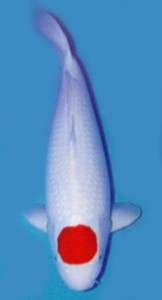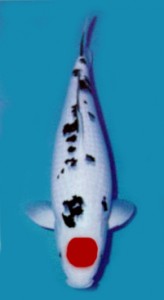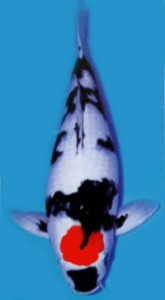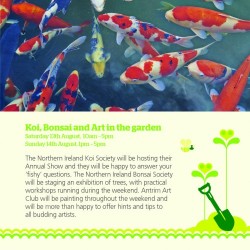Tancho
 Is named after the Japanese crane, a snow white bird with a red crest, being the national bird of Japan. It is also considered to be lucky. The single red spot on a white ground reminiscent of the Japanese flag, gives rise to the alternative name of Hinormaru and is consequently held in high esteem. Tancho generally consist of the big three varieties, namely Tancho Kohaku, Tancho Sanke and Tancho Showa, with the single red head marking being common to each. Although not bred purposely, Tancho occur naturally in the course of production of their respective varieties, nonetheless good specimens are highly prized. Tancho Kohaku, the main variety, is basically a simple Koi with a single red head marking and a white body. The head marking should be as large as possible with a circular shape being the ideal. This should lay centrally on the head without encroaching onto the eyes or extending too far towards the nose nor too far back towards the shoulders. A deep even red colour for the spot with sharply defined edges is a further essential requirement.
Is named after the Japanese crane, a snow white bird with a red crest, being the national bird of Japan. It is also considered to be lucky. The single red spot on a white ground reminiscent of the Japanese flag, gives rise to the alternative name of Hinormaru and is consequently held in high esteem. Tancho generally consist of the big three varieties, namely Tancho Kohaku, Tancho Sanke and Tancho Showa, with the single red head marking being common to each. Although not bred purposely, Tancho occur naturally in the course of production of their respective varieties, nonetheless good specimens are highly prized. Tancho Kohaku, the main variety, is basically a simple Koi with a single red head marking and a white body. The head marking should be as large as possible with a circular shape being the ideal. This should lay centrally on the head without encroaching onto the eyes or extending too far towards the nose nor too far back towards the shoulders. A deep even red colour for the spot with sharply defined edges is a further essential requirement.
Alternative shapes such as oval, square, diamond or even heart shapes are sometimes seen and although not as highly regarded are acceptable providing they are symmetrical, clearly defined and well placed. Any Hi markings, other than the single head spot, means the variety is not Tancho, even Kuchibeni lips would render a Koi simply Kohaku .In the absence of any other colour on the body the need for clear snow white skin cannot be over-emphasised as any blemishes are very easily seen and detract from the overall beauty. Fins should also be pure white without staining.

Koi – Tancho Sanke Koi – Tancho ShowaTancho Sanke is perhaps easiest described as a Shiro Bekko with a red head spot. The head marking should be as for Tancho Kohaku with no black present. The body should have the sumi markings and pattern of Bekko with well placed black markings to the upper body on fine white skin. The presence of red on the head makes for the three colours of Sanke and therefore it cannot be called Bekko, which has only two colours white and black. As with Tancho Kohaku, any further red markings on the body would turn the Koi into simply Sanke. Pectoral fins can be either white or showing the typical few stripes of Sanke.

Tancho Showa has a black and white body as found on Shiro Utsuri with the typical heavy wrapping sumi markings. A further important difference between Tancho Showa and the two preceding varieties is the fact that conventional showas do have black on the head. The shape and position of the red head spot is as previously described. Pectoral fins with the motoguro markings at the base, are a further requirement of this variety. Good specimens of Tancho Showa are rather rare but well worth seeking as they can be most striking.
Other combinations such as Goshiki or Ogon with tancho head spots are very occasionally seen and have a certain novelty value.
